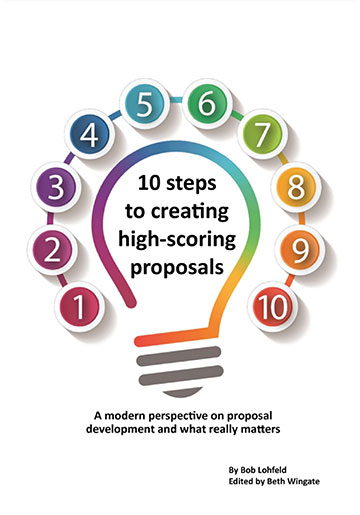No Margin for Error: How to Win SOFGSD Now

The U.S. Special Operations Command’s (USSOCOM) Special Operations Forces Global Services Delivery (SOFGSD) Indefinite Delivery/Indefinite Quantity (IDIQ) contract is one of the most coveted small business set-aside contracts in the defense market, valued at a staggering $3.2B. The bid’s mission-critical requirements range from next-gen intelligence support to top-tier program management. The competition will be fierce because it presents small businesses with the opportunity to establish or continue their presence in the national defense community.
Table 1 summarizes the SOFGSD procurement information. The remainder of the article describes key pre-request for proposal (RFP) documents, risks, and what it takes to win, given the 10 new pre-RFP documents released in June 2025.
Table 1: SOFGSD At a Glance
| Requirement | Description |
| Estimated RFP Release Date | July 2025 |
| Value | $3.2B |
| Award Type | IDIQ |
| Competition Type | Small Business Set-Aside |
| Number of Awards | 15 |
| NAICS | 541611 (Administrative Management and General Management Consulting) |
| Size Standard | $24.5M in annual receipts |
| Period of Performance | 5 base year(s) and 1 x 5-year(s) option |
| Place of Performance | MacDill Air Force Base – Tampa, Florida |
| Opp ID | 207172 |
| Opportunity Website | SAM.gov |
Summary of SOFGSD Pre-RFP Documents Released in June 2025
The government released the following SOFGSD pre-solicitation documents on June 13, which are briefly summarized below:
- Attachment 01 – IDIQ SOW
- Attachment 02 – Self Score Matrix
- Attachment 03 – Cross-Reference Matrix
- Attachment 04 – Staffing Proposal Pricing Template
- Attachment 05 – Work Sample Cover Sheet
- Attachment 07 – LCAT Description
- Draft RFP Compiled Q&A
- Section L (Draft)
- Section M (Draft)
- Section H (Draft)
Attachment 01 – IDIQ Draft SOW Summary
Attachment 01 presents the SOFGSD statement of work (SOW). It outlines the mission, priorities, and imperatives for delivering professional services to support Special Operations Forces (SOF) worldwide, emphasizing stability, agility, and reach in operations. The SOW identifies three key imperatives for the services provided:
- Stability focuses on maintaining continuity in mission support, retaining institutional knowledge, and minimizing workforce turnover.
- Agility emphasizes the importance of flexibility in managing a professional workforce in a dynamic environment, ensuring prompt responses to emerging challenges.
- Reach pertains to the ability to connect and support SOF operations globally, ensuring logistical and operational effectiveness.
The SOFGSD SOW outlines various areas of support, including:
- Education and Training Services: Support for training SOF in various environments, including curriculum development and translation services
- Management Support Services: Help with strategic planning and operational analysis
- Program Management: Support for planning and executing SOF operations
- Engineering and Technical Services: Development of technical documentation and data management
- Professional Services: Intelligence support and multimedia services
- Administrative Services: Enhancing administrative workflows and procedures
Overall, the document serves as a comprehensive guide for administering services that support USSOCOM’s mission, emphasizing the need for stability, agility, and reach in operations while ensuring compliance with security and reporting standards.
Attachment 02 – Self Score Matrix
The SOFGSD solicitation uses a comprehensive self-scoring matrix that prioritizes experience with large personnel deployments, CONUS and OCONUS multi-site performance, rapid staffing post-award, and specific labor categories (LCATs) critical to SOF missions. Offerors can earn up to 13,325 points across general and past performance categories, with most points tied to demonstrated experience in key SOW functions such as education, training, and intelligence support. The matrix also emphasizes past performance, retention rates, and the ability to transition staff rapidly—within 30 days of award. To score competitively, offerors must thoroughly document and quantify past work samples aligned with these priorities.
Attachment 03 – Cross-Reference Matrix
The Cross-Reference Matrix supports the SOFGSD self-scoring process by mapping each evaluation criterion to specific documentation requirements and artifacts, along with their corresponding locations. Offerors must cite contract artifacts—such as award documents, Federal Procurement Data System (FPDS) reports, statements of work, or Contractor Performance Assessment Reporting System (CPARS)—for each scoring category and identify page numbers and relevant government points of contact. The matrix ensures that all scoring claims are verifiable by government evaluators and directly traceable to substantiating evidence. Offerors need to complete this matrix accurately and thoroughly to validate their self-score and avoid disqualification.
Attachment 04 – Staffing Proposal Pricing Template
Offeror must identify and propose fully burdened labor rates for up to four personnel who will attend the post-award conference in person or virtually on Tab 2 of this Excel spreadsheet.
Attachment 05 – Work Sample Cover Sheet
This document includes fields for information such as the SOFGSD offeror’s name, work sample number, company name, contract details, period of performance, current cost, scope of work, and points of contact.
Attachment 07 – LCAT Description
Attachment 07 outlines 15 SOFGSD labor categories and their respective responsibilities within a military context, emphasizing roles that support intelligence, logistics, training, and cultural understanding.
Section L (Draft)
This section provides instructions for preparing SOFGSD proposals as well as instructions on the format and content of the proposal. The government details what constitutes a legitimate work sample and how it should be marked in the instructions to facilitate compliance by offerors. According to Table 2, the proposal should be organized as follows:
Table 2: Proposal Organization
| PARA. | SOFGSD VOLUME TITLE | COPIES | PAGE LIMIT |
| L-2 | Volume I – Administrative and Responsibility Material | 1 | No page limit |
| L2.3 | Executive Summary | ||
| L2.4 | Organizational Structure Change History | ||
| L2.5 | Facility Clearance | ||
| L2.6 | Adequate Accounting System | ||
| L2.7 | Financial Capacity | ||
| L2.8 | Mentor-Protégée Joint Venture Agreement | ||
| L2.9 | Contract Forms and Certifications | ||
| L2.10 | Cross Teaming Limitations, Teaming Agreements, and Identification of Subcontractors | ||
| L2.11 | Cybersecurity Compliance | ||
| L-3 | Volume II – Technical Proposal | 1 | |
| L3.2 | Work Sample Cover Sheet | No more than 5 | |
| L3.3 | Work Sample and Substantiating Data | No page limit | |
| L3.4 | HTRO Self-Scoring Matrix | ||
| L-4 | Volume III – Price | 1 | No page limit |
| L4.2 | Staffing Proposal Pricing Template | ||
| L4.3 | Cost/Price Introductory Documents |
Section M (Draft)
The Government intends to award a multiple-award IDIQ to 10–15 SOFGSD offerors, provided that at least 10 to 15 proposals are eligible for award. The government will award contracts to offerors whose proposals are deemed the best value based on a Highest Technically Rated Offeror (HTRO) approach. The HTRO approach will best achieve the objective of awarding a contract to offerors with varying core expertise in a variety of service disciplines, possessing qualities that are most important to USSOCOM.
The government will conduct the following evaluations:
- Acceptability Review: A two-step evaluation process will be employed, starting with an acceptability review to eliminate non-compliant SOFGSD proposals.
- Step 1: Proposals will undergo a review to assess their acceptability. Any proposal that is incomplete or noncompliant may be excluded from further evaluation. If a top 10 proposal fails this review, it will be replaced by the next highest-ranked proposal until 10–15 acceptable proposals remain or all have been reviewed.
- Step 2: For proposals that pass the initial review, the Government will rank them based on the offerors’ self-scores. It will then validate each self-score against the submitted documentation. If the Government cannot substantiate parts of the self-score, the score will be reduced accordingly. If the reduction eliminates a proposal from the top ten, the next highest-ranked proposal will be reevaluated, starting at Step One.
- Ranking Proposals: Proposals passing the initial review will be ranked based on self-scores, which the Government will validate. Adjustments to scores may be made if substantiation fails.
- Price Evaluation: Following validation of technical scores, price evaluations will determine whether proposed prices are fair and reasonable; any non-compliant proposals will be eliminated.
- Contract Award Determination: The final award will be based on validated scores, ensuring at least 10 contracts are awarded, with a maximum of 15. Offerors must submit comprehensive documentation to support their claims during the self-scoring process, adhering strictly to the submission requirements.
Section H (Draft)
This document outlines the procedures for issuing task and delivery orders under multiple award IDIQ contracts, specifically for SOFGSD requirements. It details the types of task orders, the emphasis on competition among contractors, and the evaluation process for proposals submitted by contractors. It identifies task order types, competition requirements, and subcontracting restrictions. It also describes the proposal submission process, the types of proposal evaluations, and the need for contractors to identify and mitigate any potential conflicts of interest, ensuring that all personnel involved in task orders comply with relevant regulations.
Draft RFP Compiled Q&A
The Q&A contains responses to 113 questions. Table 3 highlights several key impacts resulting from the Q&A.
Table 3: Key Takeaways from the Latest Q&A
| Question # | Impact on Proposal Development |
| 1 (CPARS, Note at Top) | Only fully completed CPARS are eligible for past performance scoring; offerors lacking CPARS will not receive either penalty or bonus. Teams must submit complete CPARS for relevant work samples to avoid missing points in this category. |
| 69/70 (Work Sample Tiers, JV Requirements) | JVs must ensure the SB/JV protégé brings at least one Tier 1 (prime-like) work sample. Teams structured around a mentor-protege relationship must validate that the protégé provides meaningful, qualifying past performance to establish eligibility. |
| 47/48 (CMMC and SPRS) | CMMC will not be an initial eligibility barrier; however, the Prime (or both JV leads) must have a Supplier Performance Risk System (SPRS) 110 score. Ensure evidence of SPRS compliance for proposal submission. |
| 87, 88 (OCONUS/CONUS Definition) | Accurately categorize locations for scoring. Sites in Alaska, Hawaii, and territories are OCONUS; do not count these as CONUS. Maximize points by clarifying geographic diversity as allowed. |
| 11 (Executive Summary, Volume I) | Proposals must include an Executive Summary in Volume I (see new guidance). Ensure that all required elements for Volume I are addressed according to the latest RFP instructions. |
| 53 (FCL Requirements, JVs) | TS Facility Clearance is required for both managing partners in unpopulated JVs at the time of proposal—not just one or by affiliation with a sub. Compliance with this is a go/no-go for eligibility. |
| 59 (Minimum Work Sample Duration) | Submitted work samples must include at least six consecutive months of relevant performance within the five-year window. Carefully vet project selection for eligibility. |
| 102/103 (Labor Categories/Labor Mapping) | Flexibility is allowed in mapping your internal labor categories to the RFP LCAT list, provided responsibilities and qualifications match. Clearly document and justify mappings in the proposal. |
| 3, 4, 5 (Teaming Limits, Subcontractor Work Samples) | You may use large business subs and their work samples, and subs may participate in any number of teams, with reused work samples. This enables broader teaming and leveraging of past performance. |
| 30 (Evidence/Redacted Data for Personnel/PII) | When submitting staffing evidence, use unique IDs for individuals to comply with PII redaction, but ensure that sufficient detail is provided to facilitate government validation. Prepare HR/management records accordingly. |
Potential Risks
SOFGSD is a lengthy, complex proposal. Here are some pitfalls to avoid when developing your proposal, as described in Table 4.
Table 4: Potential Proposal Development Risks
| Risk Area | Description & Rationale | Impact |
| Failure to Meet Stringent and Rigid Submission Requirements | The solicitation enforces a strict two-step process for acceptability and validation. Any deviation, incomplete submission, or ambiguity in substantiating documentation, especially in self-scoring or administrative volumes, will result in immediate elimination (see Section M2.1, M3.1). | Disqualification |
| Inability to Provide Adequate Supporting Documentation | Offeror must substantiate every scored claim—particularly for past performance, staffing, and technical criteria—with official documents (e.g., contract awards, performance work statement (PWS), contract data requirements lists (CDRLs), payrolls). Unofficial statements, summary memos, or unsubstantiated claims will be rejected, and no new or explanatory documents (e.g., narratives) can be created for this purpose. Errors or insufficient cross-referencing frequently occur in these high-volume submissions (see Section L3.3, Q&A clarifications). | Score deductions or elimination |
| Failure to Possess a Top-Secret Facility Clearance (TS FCL) | The IDIQ mandates that the prime contractor (and in JV structures, both partners) must have a TS FCL at the time of proposal submission. No exceptions, sponsorships, or substitutes will be accepted. This is a difficult hurdle, especially for small businesses and new entrants (see Section L2.5, Q&A). | Automatic disqualification |
| Inadequate or Non-Compliant Prime Contractor/Team Structure | The draft RFP strictly limits cross-teaming: a company serving as prime cannot be a sub on another team, and JV rules require the protégé (SB) to submit at least one Tier 1 work sample. Improper team formation or misunderstanding the cross-teaming limitation will cause proposals to be deemed non-compliant. Furthermore, the Government appears sensitive to “JV gaming” and large-business-backed JVs outcompeting bona fide small businesses (see Section L2.10, L3.1.8, and related Q&A). | Disqualification, protest risk |
| Risk of Receiving Zero or Negative Score in Key CPARS | Offerors must provide fully completed CPARS for each work sample. No CPARS equals zero points for that work sample. CPARS with negative or marginal ratings will trigger significant score deductions. | Low technical score, elimination |
What You Need to Win
Winning the SOFGSD contract requires a deliberate, highly disciplined approach that aligns your proposal precisely with the solicitation’s self-scoring, documentation, and compliance model. Below are the core elements and steps that distinguish a winning approach for SOFGSD, based on the solicitation’s instructions, evaluation criteria, scoring matrix, and the compiled questions and answers.
- Strict Compliance with Format and Submission Requirements: All volumes, forms, substantiation, and cross-references must adhere perfectly to Section L’s formatting and organization instructions. Your evaluation process must begin with a “go/no-go” acceptability check—any deviation, even minor, can disqualify the proposal. Only official, third-party documentation that exactly matches the self-scoring claims is considered.
- Maximizing the Self-Scoring Sheet: Earning 90% or more of the potential 13,325 points across general and past performance categories requires a thorough analysis and mapping of organizational capabilities and experience against RFP requirements. Only submit work samples and experience that directly correspond with high-value scoring line items, especially those with special weighting for SOF-relevance, size, and complexity.
- Ironclad Substantiation for Every Claim: For each item in the self-score matrix, you must provide supporting documents such as contract award documents, statements of work, CPARS, and payroll or clearance records. Unofficial summaries, desk statements, or summaries are not accepted.
- Prime Team Eligibility, Structure, and TS Facility Clearance at Submission: The Prime must have a TS FCL at proposal closing. In a JV, both partners must have a TS FCL at submission. The JV protégé (SB) must contribute at least one primary (Tier 1) work sample.
- Demonstrated High-End SOF and Intelligence Community Past Performance: Many scoring elements are doubled or weighted for SOF experience (U.S. or Allied).
- Outstanding CPARS Ratings: CPARS are the only acceptable past performance evidence. CPARS must be completed and include the required Exceptional/Very Good scores to earn corresponding points.
Conclusion
To win SOFGSD, your team must synchronize its best, most SOF-relevant experience and operational credentials, deliver flawless substantiation and compliance, and maximize self-score points—while strictly adhering to all eligibility, submission, and administrative requirements. Even a single misstep in substantiation, documentation, or team structure can disqualify an otherwise qualified proposal. Start early, rehearse your document tagging and cross-referencing procedures, and simulate the Government’s validation process before submission.
If you need assistance preparing or reviewing your SOFGSD bid, contact Lohfeld Consulting.
Relevant Information
By Brenda Crist, Vice President at Lohfeld Consulting Group, MPA, CPP APMP Fellow and Louise Fisher, CF.APMP
Lohfeld Consulting Group has proven results specializing in helping companies create winning captures and proposals. As the premier capture and proposal services consulting firm focused exclusively on government markets, we provide expert assistance to government contractors in Capture Planning and Strategy, Proposal Management and Writing, Capture and Proposal Process and Infrastructure, and Training. In the last 3 years, we’ve supported over 550 proposals winning more than $170B for our clients—including the Top 10 government contractors. Lohfeld Consulting Group is your “go-to” capture and proposal source! Start winning by contacting us at www.lohfeldconsulting.com and join us on LinkedIn, Facebook, and YouTube(TM).
Paperback or Kindle
10 steps to creating high-scoring proposals
by Bob Lohfeld
contributors Edited by Beth Wingate
Subscribe to our free ebrief
Teaming friends, frenemies, and enemies—12 tips to mitigate harmful effects
Did you know that contracting officers spend up to 20% of their time mitigating disputes between teaming partners? In an informal poll we conducted on LinkedIn last month, 40% of respondents classified their teaming partners as “frenemies” on their last bid.
Explore Further
- Advice (539)
- AI (30)
- APMP (18)
- Army MAPS Contracts (3)
- Business Development (294)
- Capture Management (266)
- Complex Technology Grants Services (26)
- Favorite Books (5)
- GenAI (4)
- Go-to-Market (27)
- Graphics (5)
- Lohfeld Books (2)
- NASA SEWP VI Contracts (2)
- Navy SeaPort-NxG Contracts (2)
- NIST MSE Grants (1)
- NIST NAPMP Grants (2)
- Past Performance (63)
- Post-submission Phase (14)
- Pre-RFP Preparation (264)
- Proposal Management (341)
- Proposal Production (77)
- Proposal Reviews (40)
- Proposal Writing (109)
- Pursuit Phase (108)
- Research Report (4)
- Resources (63)
- Tools & Tips (423)
- Training (13)
- Uncategorized (223)

Sign Up for INSIGHTS and Download your FREE book
We'd love to help you with your proposals. Enjoy our complimentary Lohfeld Consulting Group Capture & Proposal Insights & Tips book with your FREE subscription to our Insights Newsletter.
GET YOUR FREE BOOK



